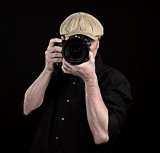Why 35mm?
-
 Topic Author
Topic Author
- Tim Kelley
- Snapobsessed
-
- Nikon D700
- Followers: 98
- Posts: 484
-
Points:
4382
Post #294562
-

- Jackson Rieger
- Snapobsessed
-
- Nikon D850 and Nikon D300
- Followers: 143
- Posts: 470
-
Points:
4486
Post #294598
In 1880 George Eastman began to manufacture gelatin dry photographic plates in Rochester, New York. Along with W. H. Walker, Eastman invented a holder for a roll of picture-carrying gelatin layer coated paper. Hannibal Goodwin's invention of nitrocellulose film base in 1887 was the first transparent, flexible film.[12] Eastman's was the first major company, however, to mass-produce these components, when in 1889 Eastman realized that the dry-gelatino-bromide emulsion could be coated onto this clear base, eliminating the paper.[13]
With the advent of flexible film, Thomas Alva Edison quickly set out on his invention, the Kinetoscope, which was first shown at the Brooklyn Institute of Arts and Sciences on 9 May 1893.[14] The Kinetoscope was a film loop system intended for one-person viewing.[15] Edison, along with assistant W. K. L. Dickson, followed that up with the Kinetophone, which combined the Kinetoscope with Edison's cylinder phonograph. Beginning in March 1892, Eastman and then, from April 1893 into 1896, New York's Blair Camera Co. supplied Edison with film stock. At first Blair would supply only 40 mm (1-9/16 in) film stock that would be trimmed and perforated at the Edison lab to create 1-⅜ inch (34.925 mm) gauge filmstrips, then at some point in 1894 or 1895, Blair began sending stock to Edison that was cut exactly to specification.[4][16] Edison's aperture defined a single frame of film at 4 perforations high.[17] Edison claimed exclusive patent rights to his design of 35 mm motion picture film, with four sprocket holes per frame, forcing his only major filmmaking competitor, American Mutoscope & Biograph, to use a 68 mm film that used friction feed, not sprocket holes, to move the film through the camera. A court judgment in March 1902 invalidated Edison's claim, allowing any producer or distributor to use the Edison 35 mm film design without license. Filmmakers were already doing so in Britain and Europe, where Edison had failed to file patents.[18]
At the time, film stock was usually supplied unperforated and punched by the filmmaker to their standards with perforation equipment. A variation developed by the Lumière Brothers which used a single circular perforation on each side of the frame towards the middle of the horizontal axis.[19] It was Edison's format, however, that became first the dominant standard and then the "official" standard of the newly formed Motion Picture Patents Company, a trust established by Edison, which agreed in 1909 to what would become the standard: 35 mm gauge, with Edison perforations and a 1.33 aspect ratio.[20] Scholar Paul C. Spehr describes the importance of these developments:
The early acceptance of 35 mm as a standard had momentous impact on the development and spread of cinema. The standard gauge made it possible for films to be shown in every country of the world… It provided a uniform, reliable and predictable format for production, distribution and exhibition of movies, facilitating the rapid spread and acceptance of the movies as a world-wide device for entertainment and communication.[16]
The film format was introduced into still photography as early as 1913 (the Tourist Multiple) but first became popular with the launch of the Leica camera, created by Oskar Barnack in 1925.[21]
-

- Don Fischer
- Photography Hooked
-
- Nikon D5000
- Followers: 341
- Posts: 989
-
Points:
2442
Post #294628
-

- Stealthy Ninja
- Moderator
-
- Fuji X stuff and a 1DsIII for some reason
- Followers: 982
- Posts: 16300
-
Points:
6837
Post #294693
Latest Reviews
The Fujifilm XT5 is a 40MP mirrorless camera capable of 6.2K video at 30p. With those specs, it’s an ideal choice for photographers needing a camera to pull double duty for imaging and video.
The Canon EOS R100 is an entry-level mirrorless camera introduced in 2023. But just because it’s an entry-level camera doesn’t mean it’s a bare-bones camera. Find out why in this review!
Nikon’s retro-looking Nikon Zfc is anything but retro. Under its classic body is a host of features and amenities that make it a worthwhile compact mirrorless camera for 2024.
The Canon EOS R50 is one of the newest R-system cameras from Canon. Is it worth your money? Find out all the details you need to know in this comprehensive review.
Forum Top Posters
-
1TCav 10 posts
-
2CharleyL 6 posts
-
3Sawyer 5 posts
-
4db3348 3 posts
-
5Jason Stevens 3 posts
-
6Randy Shaw 3 posts
-
7Razky 3 posts
-
8Hassner 3 posts
-
9AstralArti... 3 posts
-
10Tristan R 3 posts
Latest Articles
The Nikon D850 might be an older DSLR, but it was ahead of its time when it debuted in 2017. That means it still has plenty of firepower to compete with today’s powerful mirrorless cameras.
The best beginner camera isn’t the same for everyone. That means having choice is of the utmost importance. In this guide, explore five excellent beginner camera options for 2024 and beyond.
Child portrait photography is a unique undertaking requiring special skills and talents to get the best results. Start mastering this photography niche with these essential tips!
The Fujifilm XT5 is a 40MP mirrorless camera capable of 6.2K video at 30p. With those specs, it’s an ideal choice for photographers needing a camera to pull double duty for imaging and video.
Using leading lines in photography helps improve the composition by drawing viewers in and leading their eye from the foreground to the background. Explore some fine examples of this in this guide!
The Insta360 has one of the best lineups of action cams and 360-degree cameras. With these Insta360 accessories, you can elevate your photography and videography game!
Creating impactful photos of landscapes depends on many factors, not the least of which is your talent behind the lens. This guide explores other elements required for the best product.
The Canon EOS R100 is an entry-level mirrorless camera introduced in 2023. But just because it’s an entry-level camera doesn’t mean it’s a bare-bones camera. Find out why in this review!

















